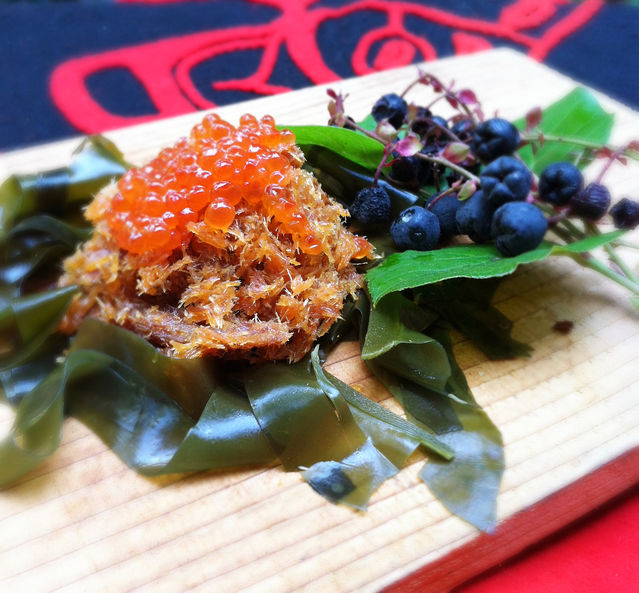Diet
There Is No One Right Diet for Everyone
Exploring the spectrum from carnivore to vegetarian
Posted March 28, 2016

Coast Salish Peoples Food
In psychotherapy, we treat the individual, not the illness. In nutrition, individuals have unique needs and require different nutrients and foods to address specific requirements. The term biochemical individuality was coined by Williams (1998) to explain the biochemical and metabolic differences among people and the wide variation in response to nutrition. The three major principles of biochemical individuality are as follows: (1) there is no one diet for everyone, (2) dietary needs can change throughout the life cycle, and (3), nutrition must focus on the individual, not the disease.
Metabolic analysis is a method of assessing biochemical individuality based on the Krebs cycle, the speed of glucose oxidation (Kristal & Haig, 2004). Oxygen alkalinizes the blood, while carbon dioxide, which is produced as a by-product of the oxidation process, is acid-forming. The optimal ratio between them is intimately connected with maintaining the optimal blood pH of 7.46. At this pH level, all of the systems of the body function harmoniously. If there is an excess of oxygen, the blood becomes overly alkalinized, with the converse, acidification, occurring from an excess of carbon dioxide (Kristal & Haig, 2004). People who oxidize carbohydrates fast require more protein and fats to slow the glucose combustion process. People who burn them more slowly require more glucose (carbohydrates) to fan the flames. This determines whether one will function best physically and mentally as a carnivore, omnivore, or closer to the vegetarian end of the spectrum since foods like vegetables and fruits alkalanize and animal proteins acidify.
Biochemical individuality is rooted in the intersection of genetics, environment, and cultural/ethnic heritage. For example, the traditional diets of the Inuit of the circumpolar region are rich in fat and blubber from fish and sea mammals supplemented with seaweeds and small amounts of fruit in the form of summer berries. This diet has sustained the Inuit for centuries without adverse health effects and evolved as a function of people and place. Not until colonization and 20th-century development brought refined flours, sugars and soy protein as substitutes for their traditional diets did the Inuit suffer suicide, depression, and heart disease. While not as rich in fat and seafood as the diet of the Inuit, the daily intake of the American Indians of the Pacific Northwest also depended historically upon huge stores of fresh, dried, and smoked salmon and oolichan (smelt) along with the meat of deer and elk, huckleberries, and starchy roots. So central was the oolichan to the lives of the native peoples that the name Oregon derives from this little powerhouse of a fish.
Before 1493, wheat, beef from cattle, milk, and pork did not exist in the western hemisphere; therefore these foods may not be the most beneficial to peoples indigenous to this region. By contrast, peoples in India evolved in a warmer climate with subtropical foods and an emphasis on more vegetables and carbohydrates. The tropical peoples of Mesoamerica, Africa, and India have accessed fats from nuts, plants, ducks, insects, and turkeys, and they have depended upon many more vegetables, fruits, and grains endemic to their regions. Weston Price, in the course of his global travels in traditional societies, asked the question: “Who is the healthiest among peoples on the planet?” In looking for an answer, he found that they all consumed moderate amounts of animal fats, suggesting that our modern fears of saturated fats are among the paradigmatic myths of modern medicine.
Peter D’Adamo’s (2001) “blood type diet” is a popular, simple subcategory of metabolic analysis that focuses on the role of specific sensitivities to lectins in determining dietary needs and reactions. Lectins are specific proteins present in large quantities in certain beans, grains, potatoes, and nuts. D’Adamo asserts that the different blood types benefit from certain foods and are especially sensitive to foods with specific lectins. The role of these lectins is to adversely affect the delicate lining of the the intestinal tract. D’Adamo (1996) suggests that people with type O blood have lower levels of the enzyme monoaminoxidase (MAO) inhibitor, which may explain why many such people react poorly to St. John’s wort (a MAO inhibitor) or have disturbing dreams. He also suggests that people with type A blood respond to stress with higher levels of cortisol than the other blood types. The blood type diet is a good 1st step approach with clients undergoing dietary changes. Over time they can continue to integrate additional aspects to Metabolic analysis.
If you are interested in learning more about the traditional foods of peoples of the Pacific northwest or Mexico, explore these following resources:


